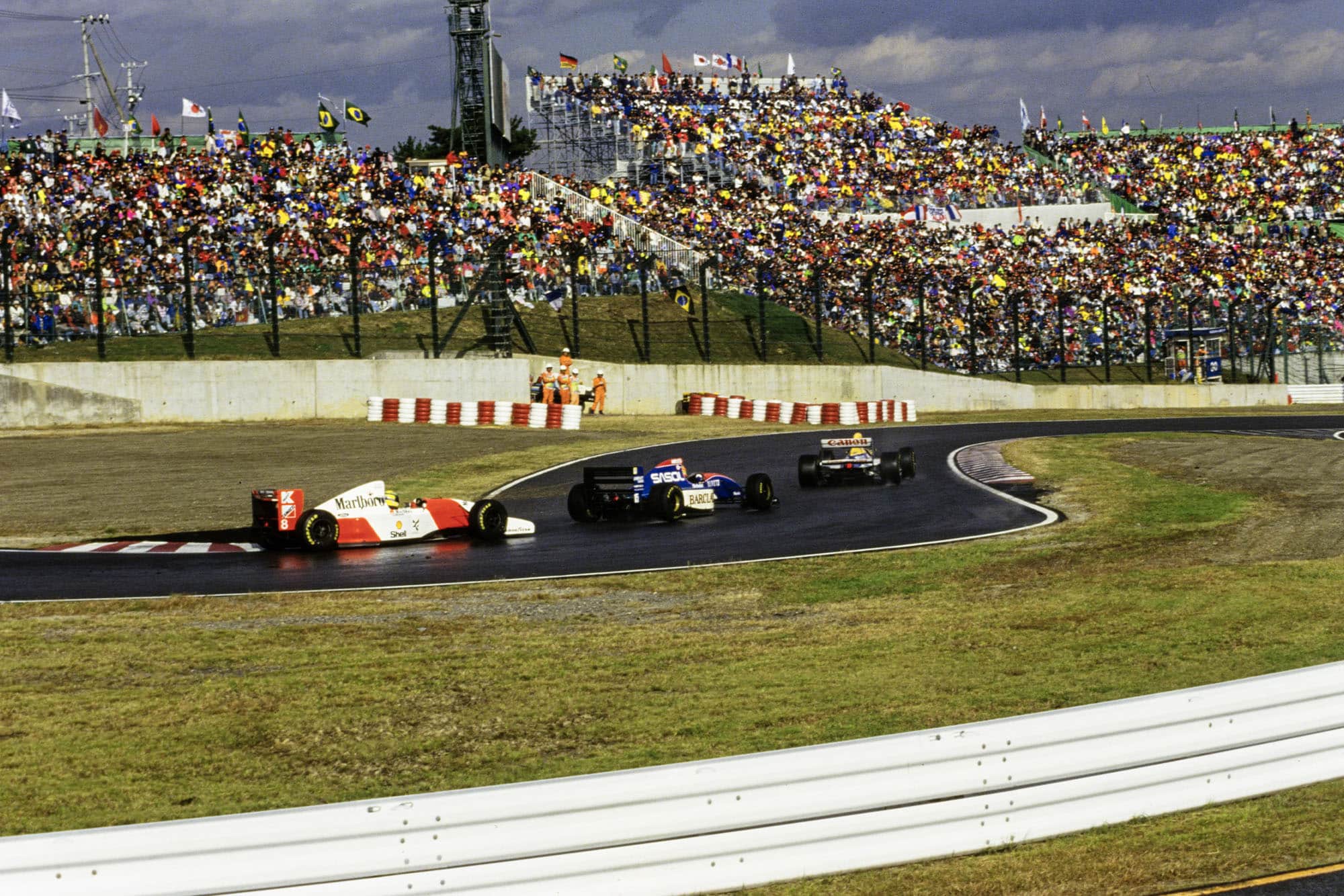Storms over Suzuka
The weather played a crucial part as Senna scored his 40th triumph – and McLaren’s record equalling 103rd – but the real storm came in the paddock afterwards, as he assaulted newcomer Eddie Irvine
I don’t know quite what it is about Suzuka, but it has a funny effect on Ayrton Senna. Since his Honda days the Brazilian has always been very popular with the thousands of Japanese spectators, and the man himself said after the 40th victory of his F1 career: “The fans here are special and they deserved a good race, and my own victory here is special because this is where I won three World Championships.”
Well, the Japanese got a good race, all right, and Ayrton drove brilliantly in changeable conditions, but what happened afterwards with Eddie Irvine saw him fall from grace in a big way and left a lot of the locals totally bemused:
The results of qualifying promised much, for the first five cars — and four marques — were separated by less than half a second. Prost had duly wound up his Williams-Renault to take yet another pole position, and while Damon Hill had spun off quite heavily, after setting what at the time was pole, Senna, Hakkinen, Schumacher and a one-time fastest Gerhard Berger were all snapping at the Frenchman’s heels.
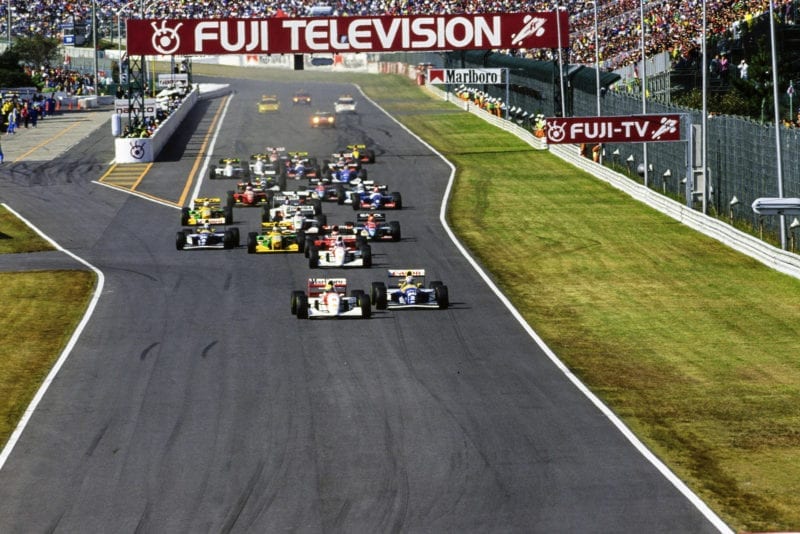
Ayrton Senna covers off Alain Prost as the pair head into Turn One
Motorsport Images
Three years ago Senna was creating about having to use the inside line for his pole position. Things have changed since then, and by irony he still found himself there even though he was only second quickest. Three years ago we had witnessed that infamous moment when, by his own admission a year further on, he had deliberately rammed Alain Prost’s Ferrari out of the race. This time, Williams was feeling very confident about its prospects, but suspected that Senna would have the upper hand in the early stages. Thus it was to prove. Off the line the Brazilian catapulted into the lead, with the fuel-heavier Prost next up from Hakkinen and Berger.
“It’s six years that I’ve started on the inside line and this time I got it right,” said Senna with evident relief.
In the Ferrari’s wake, Irvine lived up to expectations with an audacious move round the outside of Schumacher to grab an excellent fifth. The Ulsterman had used his circuit knowledge to the full in qualifying, to line up an excellent eighth and to put a whole new set of colours in Jordan teammate Rubens Barrichello’s paintbox. Hill followed them in seventh place, but Alesi’s expected charge had not materialised, the Frenchman having an awful weekend after two shunts in qualifying before he had really been able to get into his stride. Suzuki had got away better than Warwick, after the Briton had run rings round him all through practice, and the Japanese driver was eighth ahead of his team-mate, Patrese, Lehto, Wendlinger, Alesi, Brundle, Barrichello, Katayama, Herbert, Blundell, Toshio Suzuki (who had taken over the second Larrousse from Philippe Alliot for the last two races), Martini, Lamy, Comas and a limping Jean-Marc Gounon (who had replaced Fittipaldi at Minardi).
In fact, Gounon had made an excellent start, only to fall foul of de Cesaris as they contested the same piece of track. The Italian was an instant retirement, while the Frenchman would hobble home for repairs before continuing until Giancarlo Minardi decided he had fallen so far back that there was no hope of being classified. Budgetary considerations then obliged him to retire his second car after the newcomer had completed 26 laps.

Mika Hakkinen on the way to his first podium finish of his Formula 1 career
Motorsport Images
In the early stages the sky was bright blue but, shortly after the start, clouds began to drift across Suzuka and it soon became apparent that rain was not just a threat, but a strong likelihood. Senna looked comfortable enough leading ahead of Prost, while Hakkinen was equally well established in third place. Schumacher’s initial efforts to pass Irvine were repelled – cleanly, Michael was careful to point out – but eventually he got by in the S Curves on lap three. Hill followed suit three laps later, and then Suzuki did likewise on lap eight. Already, the uncomfortable driving position in the Jordan had begun to numb Eddie’s legs, so that he was having real trouble using full throttle.
Schumacher and Hill were now well placed to launch an attack on Berger, but Damon swept ahead of Michael on lap 10 as they chased after the Ferrari. Coming into the chicane on lap 11 Damon tried the outer line and sat alongside the red car, but he stayed there far too long, for there was never going to be any chance of getting by that way. Schumacher watched all this and, seeing his chance, tried to squeeze up the inside of the Williams. It was the classic Suzuka chicane recipe for disaster for somebody, and the somebody was Michael.
As Gerhard kept Hill pinned on the outer line, Damon finally began to brake extra hard to try and drop back in behind him, and just as he began to do that, he found Schumacher in the way. As it cut across the Benetton’s bows, the Williams’s sidepod scraped the BI93B’s left front wheel. It didn’t look a particularly hard jolt, but as the Ferrari and the Williams sped down the hill past the pits, Schumacher pulled over to the left, to retire. The front left suspension had been damaged too much to continue.
“Hill overtook me quite easily and I thought, ‘OK, I can’t do anything, but perhaps he is able to pass Berger'” said the German. “But Hill was so slow through the corner and I thought, ‘He can’t overtake Berger, so I’ll have to try and overtake him again’. As Hill tried to pass Berger on the outside, I tried to stay very close to Berger so Hill couldn’t move inside, but actually he did and I hit his wheel. The impact knocked my wheel off and that was it. I tried something which didn’t work.”

Michael Schumacher in the Benetton
Motorsport Images
Alesi’s troubled run, bottled up behind the two Saubers and only just ahead of Brundle, also ended at the chicane. On lap eight he had pulled off to the right, his Honda-headed Ferrari V12 having broken on lap eight.
Hakkinen was the first of the front runners to stop for fresh Goodyears, and his ultra-quick call on lap 11 still left him third when he resumed. Berger came in a lap later, and was also despatched swiftly, within 5.4s. At this stage, however, there was more black than blue in the sky, and the first rain spots were detectable by lap 16. Senna had come in for a new set of slicks on lap 13, surrendering his lead to Prost, so that as the onset of the rain became fully apparent, the order was Prost, Senna, Hakkinen, Hill, the amazing Irvine, Warwick, Patrese, Berger, Barrichello, Katayama (going very well on Yamaha’s and his home ground), Suzuki A, Brundle, Lehto, Wendlinger, Herbert, Blundell and Martini, with Lamy, Suzuki land Gounon already lapped. Comas had retired on lap 18 with a broken Lamborghini V12.
By lap 20 everything changed as the rain came flooding down, and everyone began diving for the pits again for wet tyres. By the time everything had settled Senna had regained the initiative, and when a measure of sanity was restored again by lap 25 a revised pattern had emerged. Senna was ahead of Prost, with Hakkinen third from Hill, but Warwick had moved to fifth from Berger, Barrichello, Patrese, Brundle and Irvine. The latter had been obliged to do two slowish laps on slicks in the wet as Barrichello had claimed first pit call by radioing in sooner, only then to decide to delay his stop by a further lap. Lehto was lapped in 11th, as Herbert tried to stay ahead of Suzuki, who was in turn chased by Katayama, Wendlinger, Blundell, Martini, Lamy, Suzuki T and Gounon.
Hill had come off worst of all. He had already gambled on a very low downforce set-up, with three and a half slots less rear wing than Prost, but any chance to exploit that had been negated as he was bottled up behind Berger and inexorably lost time to Prost and the McLarens. Then came a puncture.
“I could see it was going to rain and I wanted to stay out as long as I could, but I had to come in for fresh slicks because of that puncture. It was certain to rain, so that meant I had to come in again later for wets. As a result I lost 20s or so on the road there and then, which was a shame as I had just started to get clear and into the groove.”
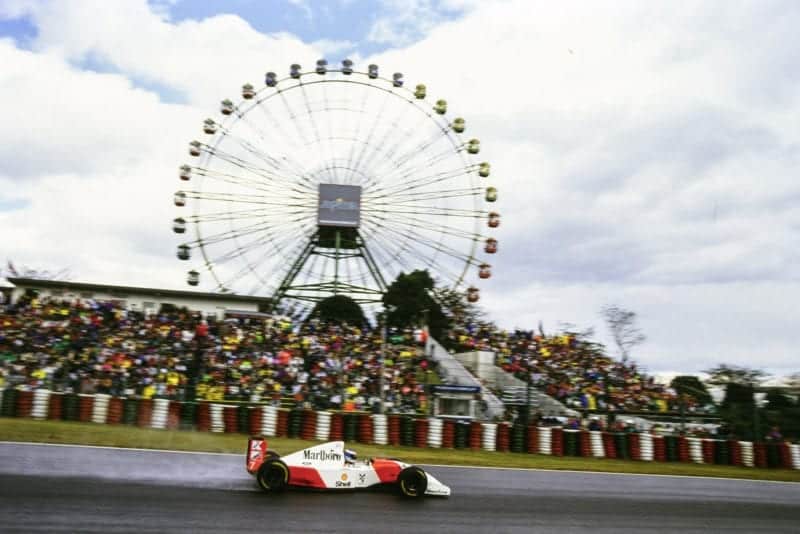
Mika Hakkinen
Motorsport Images
The conditions were now pretty dire, but Senna looked thoroughly at home as he opened out a 29s lead. Following an initial push after Prost, Hakkinen had begun to fall back, taking the sensible route. The Finn was determined to finish at all costs, and wasn’t prepared to take any unnecessary chances. Dry lines were beginning to appear in places, but the S Curves in particular remained wet enough to warrant wets, as off-course moments for both Hill (lap 28) and Prost (lap 29) testified.
During his, Damon rejoined immediately in front of Toshio Suzuki, who was clearly incensed. As Damon slithered round trying to regain his momentum, the newcomer tried to force back inside him at the hairpin and to edge him wide, off the track. The two of them tip-toed through, but Damon just managed to draw himself out of trouble.
Another stop on lap 33 dropped him back to sixth as he decided it was just dry enough to risk slicks, and that promoted Warwick to fourth with Barrichello pushing hard after the Footwork. Berger, meanwhile, came in for more wets on lap 31, then decided dries were the real answer and came in again two laps later, dropping right out of contention.
The scene was now set for the situation which would later prompt Senna’s anger against Hill and Irvine. The latter pair were fighting over fifth place as Ayrton came up to lap them on lap 34, and having got by the Jordan Senna found that the slick-shod Williams was quicker than his wet-shod McLaren in places. Overtaking was not a straightforward task, and that allowed Irvine to come back and he swiftly unlapped himself. Naturally, this didn’t go down too well with Ayrton! When he tried to lap Irvine again, the Ulsterman resolutely repelled his advances.
As the three of them came up to the chicane on lap 34 Brundle’s Ligier shed its left rear wheel right in front of them. The Briton, who had had the mother and father of testing shunts at Magny-Cours the previous week and had (despite a spin on lap 13) been driving with far greater commitment than one might have expected after such a shock, was pushing hard in an effort to regain ground. “At first I thought I’d just got a puncture,” he admitted, “then I saw my wheel going by!” The current breed of F1 cars is so stiff that the back end didn’t drop on to the track, and he was able to tricycle slowly back to the pits. Fortunately, neither Hill, Irvine nor Senna struck the errant wheel and tyre, but it was a close call.
During Irvine’s intervention in his progress Senna’s lead had shrunk from 30s on lap 34 to a mere 15.1s on lap 37, by which time he had finally made a passing move on Irvine stick as they went under the bridge.
Three laps later Berger’s demise with a blown engine in the first corner proved bad news for Herbert, who flat-spotted his new slicks after sliding on the Italian V12’s oil and thus had to pit for a fourth time. Neither Lotus, however, was in the hunt on a bad day for the Hethel team. Johnny would resume 14th right behind team-mate Lamy, whose active warning light was flashing on and off all the way through the race.
Senna quite clearly had full control, and Prost was not going to mount any sort of challenge at this stage. “I was not worried at the start,” he admitted of Senna’s lead. “I thought it would be just a one-stop race and I knew my tyre wear was fantastic and that I could have gone through without making any change if I had wanted to, even though the lap times would have been slow. When I saw Ayrton stop, I thought it would be very interesting at the end of the race – and then it rained!
“When I made my stop it was a very long one. There was a problem with the left-front wheel and when I was off the jacks I had to wait for Mika, who was in my way. It must have been 20s or something. From then on the car was fantastic in the wet/dry conditions. It was very light and I enjoyed driving it. When I came in again, I knew with only one dry line it was not worth taking risks with just one race to go.”
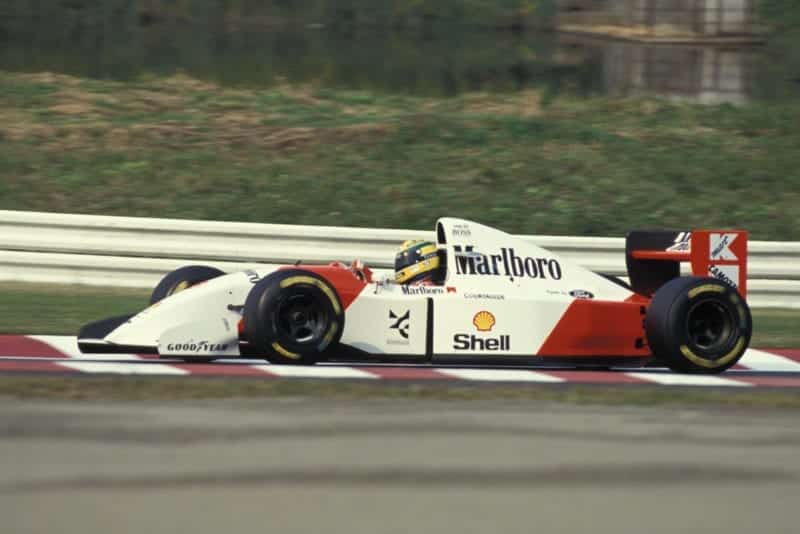
Senna on the way to a fourth win in the 1993 season
Motorsport Images
With Hakkinen still sensibly concentrating on taking third place, the battle for fifth place in Hill’s wake held the most attention. For a long time Warwick looked the most likely candidate, but then Barrichello got by him during their stops, and as the race went into its last 10 laps Irvine was coming back at Derek with a vengeance. If any battle was likely to end in tears it was this one, and going into the chicane on lap 49 Eddie hit the Footwork up the back and pushed it into a spin that left it in the sandtrap. For Derek it was Estoril all over again.
“I was 20 or 30 km/h quicker than him through 130R, and when I got alongside him on the inside he just moved me over on to the grass and got shit all over my tyres,” claimed the Ulsterman. “When we got to the chicane he braked way too early, and there was no way I could stop.”
Derek took a completely different view, and was furious that for the second race in succession another driver’s mistake had cost him points he had thoroughly deserved. It was clear from the video that Irvine hadn’t locked up in the chicane, and many felt his manoeuvre had been a cynical tactic. He was called to the stewards afterwards, before the incident with Senna, but no action was taken. It should have been.
On lap 46 Patrese had a huge shunt coming through Dunlop, the uphill, lefthand, fifth gear bend behind the pits. “The car felt quite nervous when I went back to slicks,” he said, “and due to contact with someone earlier in the race the oil cooler had been damaged. Eventually it split and oil sprayed all over the right rear tyre. It was a big accident.”
No sooner had he limped away, visibly shaken, than Lamy too went off at the same place four laps later. The Portuguese driver was of the firm belief that his active suspension had failed, as the undertray had been scraping the ground, even on the straight, for some time.
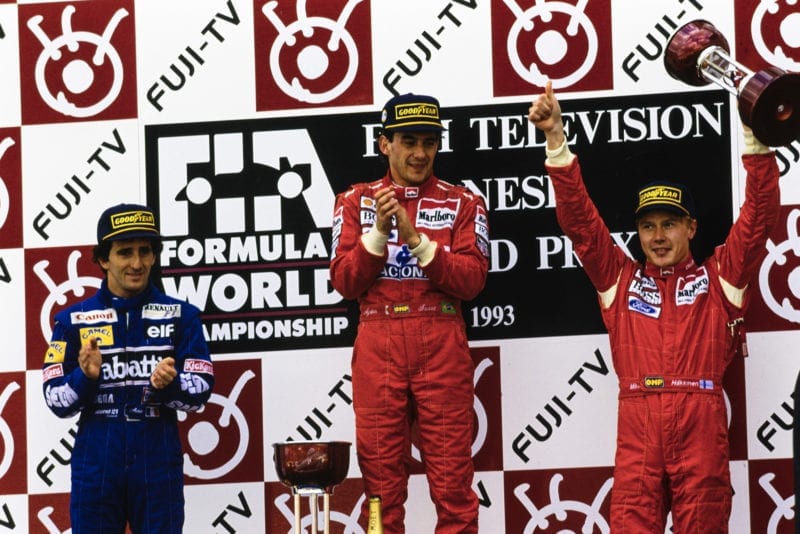
Hakkinen celebrates his first Formula 1 podium finish
Motorsport Images
Brundle had made some stunning progress after having a new set of tyres slapped on in his enforced stop, and had set the fastest lap until Prost beat his time on his last tour. Martin had caught and passed team-mate Blundell, who’d had to take the spare JS39 after his race car developed a gearbox problem just before the start. Troubled by a long brake pedal and a sensor problem in his transmission, he could offer no resistance as Martin steamed by, but the latter’s progress came to an end when he arrived too quickly at the chicane and ran into the back of Lehto. The surviving Sauber (Wendlinger had long retired with a sticking throttle) was pitched into a spin which let Mark back ahead, while Martin was stranded with a stalled Renault V10. He was classified ninth, and became embroiled in a screaming match with Lehto in the paddock afterwards. It was a shame to see two normally placid drivers indulging in such a verbal battle, but that rather summarised the race. Martini was a reliable 10th from Herbert, debutant Toshio Suzuki, and the non-running Lamy and Warwick.
Curiously, Senna cold-shouldered Prost throughout the victory speeches, making one wonder what each had done to upset the other this time, but though he also alluded to the behaviour of other drivers during the race – “some of the backmarkers were very stupid” – he seemed calm enough. It was his 40th victory, and one that brought McLaren alongside Ferrari in the overall win stakes, with 103 apiece. Perhaps that was what they started discussing, perhaps Gerhard Berger was just being his usual mischievous self, but it is generally thought to have been the Austrian joker who pointed out to Ayrton just what Irvine had subsequently been saying in response to Senna ‘s reported criticism. That, it seems, is what set the final Suzuka drama in motion . . .
D J T
The Irvine/Senna battle is decribed in greater detail in Delirium Tremens, on pages 1202/1203.
